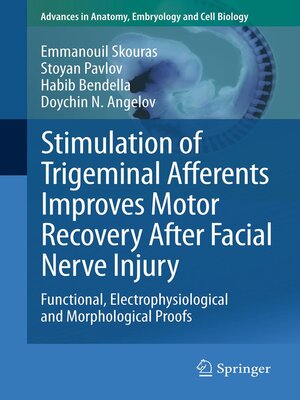Stimulation of Trigeminal Afferents Improves Motor Recovery After Facial Nerve Injury
ebook ∣ Functional, Electrophysiological and Morphological Proofs · Advances in Anatomy, Embryology and Cell Biology
By Emmanouil Skouras

Sign up to save your library
With an OverDrive account, you can save your favorite libraries for at-a-glance information about availability. Find out more about OverDrive accounts.
Find this title in Libby, the library reading app by OverDrive.



Search for a digital library with this title
Title found at these libraries:
| Library Name | Distance |
|---|---|
| Loading... |
Recovery of mimic function after facial nerve transection is poor: the successful regrowth of axotomized motoneurons to their targets is compromised by (i) poor axonal navigation and excessive collateral branching, (ii) abnormal exchange of nerve impulses between adjacent regrowing axons and (iii) insufficient synaptic input to facial motoneurons. As a result, axotomized motoneurons get hyperexcitable and unable to discharge. Since improvement of growth cone navigation and reduction of the ephaptic cross-talk between axons turn out be very difficult, the authorsa concentrated on the third detrimental component and proposed that an intensification of the trigeminal input to axotomized electrophysiologically silent facial motoneurons might improve specificity of reinnervation. To test the hypothesis they compared behavioral, electrophysiological and morphological parameters after single reconstructive surgery on the facial nerve with those obtained after identical facial nerve surgery, but combined with direct or indirect stimulation of the ipsilateral infraorbital (ION) nerve. The authors found that in all cases trigeminal stimulation was beneficial for the outcome by improving the quality of target reinnervation and recovery of vibrissal motor performance.







